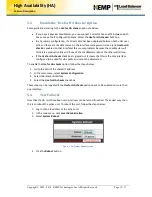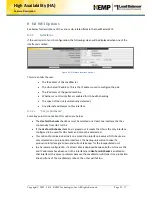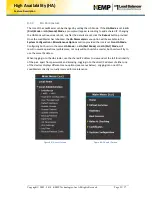
Copyright © 2002 - 2014 KEMP Technologies, Inc. All Rights Reserved. Page 25 / 37
High Availability (HA)
Feature Description
Switch to Preferred Server
By default, neither partner in a HA cluster has priority. So that when a machine restarts after a
switchover, the machine becomes the slave and stays in that state until forced to master.
Specifying a preferred host means that when this machine restarts, it will always try to become
master and the partner will revert to slave mode.
For normal operating conditions, KEMP recommends selecting
No Preferred Host
.
HA Update Interface
The interface used to synchronize the entire HA configuration within the HA cluster.
Synchronization occurs every two minutes. The information is synchronized over SSH port 6937.
Force Partner Update
Immediately forces the configuration from the active to standby unit without waiting for a
normal update.
Inter HA L4 TCP Connection Updates
When using L4 services, if updates are enabled it allows L4 connections to be maintained across
a HA switchover. This option is ignored for L7 services.
Inter HA L7 Persistency Updates
When using L7 services, if this option is enabled it allows persistence information to be shared
between the HA partners. If an HA failover occurs, the persistence information will not be lost.
Enabling this option can have a significant performance impact.
HA Multicast Interface
The network interface used for multicast traffic which is used to synchronize Layer 4 and Layer 7
traffic when Inter HA Updates are enabled.
Use Virtual MAC Addresses
Selecting this option creates a shared MAC address for both units. When failover occurs, the
LoadMaster will handle the MAC address handover too. This allows the switches to keep the
same MAC address and not worry about ARP caches or stale records. This is useful when
gratuitous ARPs (used in communicating changes in HA IP addresses to switches) are not
allowed.
This option is not available in VLMs because they are not physically
connected.













































